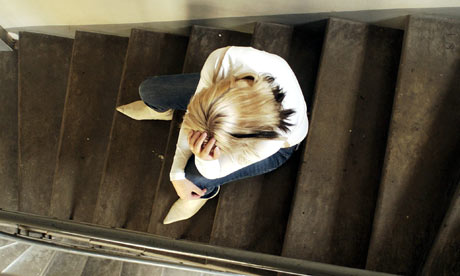
Patti Adler, professor of sociology at the University of Colorado, had never met anyone who self-harmed, until 1982. When she did, it was a student of Adler's husband, Peter, also an academic. "When we mentioned it to friends, nobody had heard of it – it was unfathomable," she says.
But over the years they began to notice it with increasing frequency among their students, until finally, in 2000, the Adlers decided to start studying the phenomenon.
What surprised her most, she says of the research that has become a book she wrote with her husband, The Tender Cut, is how "in the period when we studied it, it took off like wildfire. And how many older people were still doing it. That's a much more hidden population. I think it's more stigmatising for older people to be doing it because it's not as common as with teenagers."
Over 10 years, the Adlers conducted interviews with 135 people who self- injured, and trawled through thousands of posts on internet forums dedicated to self-harmers. When Adler started, most studies of self-harm focused on people with severe mental illness, such as schizophrenia – with the result that it had been categorised as a mental disorder – but she found a huge number of people who "never wound up in hospital, were not necessarily psychiatric cases but they had some toughness in their life… although it didn't have to be that severe". A large proportion traced their self-injury back to childhood trauma or abuse, or some devastating event in their life, such as rape.
But there was also a huge number of people who started in response to fairly typical teenage stresses. "[It affects] people who have some kind of emotional distress," Adler says. "People who are either overwhelmed by it and want to quiet it, or are dead from it and want to express it. It does both – it releases emotions and stills them. Some people feel a lack of control and they want to at least have control of when and how they inflict pain."
Adler views self-harm as a kind of "self-help", rather than a near-suicidal expression. Self injury, she writes, "tends to lead to the lessening of tension, euphoria, improved sexual feelings, diminution of anger, satisfaction of self-punishment urges, security, uniqueness, manipulation of others, and relief from feelings of depression, loneliness, loss, and alienation".
The most common method of self-injury is cutting, although Adler interviewed people who used a wide range of methods from scratching themselves to breaking bones.
As sociologists, the Adlers were fascinated when, in the mid-1990s, self-harm became what Adler describes as "faddish". Adler cites the both the media and musicians such as Nine Inch Nails' Trent Reznor and Marilyn Manson, "who started cutting themselves on stage and talking about it. Celebrities came out, including Princess Diana, Johnny Depp, Fiona Apple and Angelina Jolie, and there were movies, such as Girl Interrupted, which featured it. It started to be discussed in health classes." (Teenagers, she says, are vulnerable because "it's a time of extreme hormone change and people feel very emotional and overwhelmed".)
With the explosion of the internet, a community was created. "People had been isolated and thought they were crazy, because that's what people were being told. A couple of people who I talked to had mentioned it to a school counsellor who called their parents, and they would check their kid in to the mental hospital. So to find other people who said 'I do this too, you're not alone, you're not crazy' was such a huge relief."
Around 85% of the people Adler interviewed were women. "It's part of women's gender socialisation to turn inwards and self-destruct when they are upset," she says. "Men, when they are upset, tend to get angry; they externalise." Women tend to make small, hidden cuts, she says, whereas men tend to cut themselves more visibly.
What had started as something that mainly seemed to affect middle-class, white, teenage girls, Adler started to notice in older people – often as a response to stress in their lives, perhaps as a result of divorce or redundancy – ethnic minorities and men.
So how worried should people be by self-harm? Adler is sanguine: "A lot of people quit when they get out of the situation that's triggering it, but not everybody does." Some of the people Adler interviewed stopped with the help of therapy or antidepressants; others continued into their 40s and 50s, occasionally worsening, but, she says, "there tends to be a natural turning point where people drop off. As you get older, there are fewer [people who self-harm]. Teenagers who started in their early teens still constitute more than 50% of the [number of self-harmers]. I would say the next biggest group is people in their 20s, and then there's a dropoff." The people who self-harm to fit in with a social group – this became another curious part of her research – or see it as a passing fashionable rebellion "fall off earlier. I think it will peak as a fad eventually, and then settle down".
For more information or help dealing with self-harm, visit: mind.org.uk; samaritans.org; nhs.uk/conditions/Self-injury

